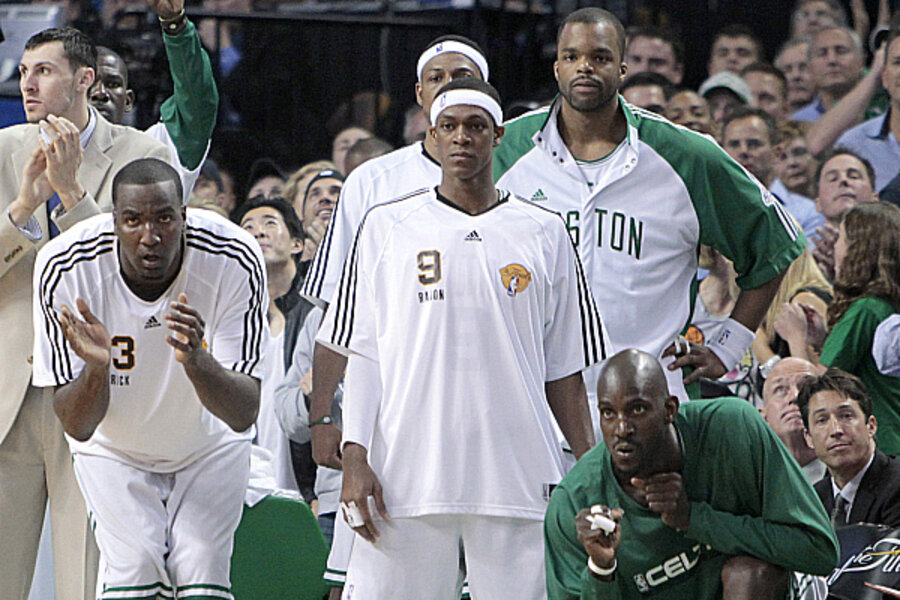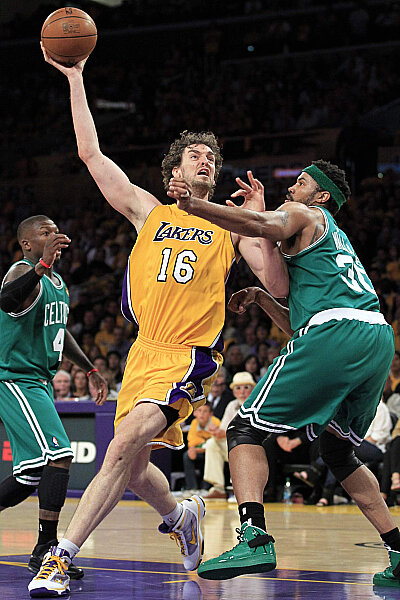NBA finals: Where in the world will the next Pau Gasol come from?
Loading...
| Boston
Pau Gasol's pivotal role in the Lakers-Celtics NBA finals epitomizes the shift that has occurred in the NBA’s supply-chain for international basketball players over the past several decades.
Mr. Gasol, a Spaniard drafted in 2001, comes from Western Europe – the source of many of today's best international basketball players.
Fellow top players Dirk Nowitzki (drafted in 1998) and Tony Parker (drafted in 2001) come from Germany and France, respectively. All three are among the few non-Americans with repeated appearances on the NBA All Star Team in the past decade.
Sasha Vujacic, the Los Angeles Lakers' shooting point guard, is from Slovenia, but started his professional basketball career at age 16 in Italy. And teammate Didier Ilunga-Mbenga was born in Congo, but fled at an early age to Belgium.
Such Western European dominance is a trend of the past decade, whereas in the 1990s and 1980s the Soviet Union and Yugoslavia provided the wellspring of basketball greats.
And now, scouts are trying to gauge where the next shift might appear.
In May, the National Basketball Association (NBA) opened its first office in Africa, in South Africa’s capital of Johannesburg. In the past year, the league launched the NBA in Arabic and the NBA in India. In addition to 16 offices already in major cities including Beijing, Shanghai, and Hong Kong, the league plans to set up offices in India, Russia, and Brazil by the end of 2010. While most offices are geared toward bringing in new NBA fans, there's nothing that draws fans like a star from their own country.
“We’re doing a real big push right now in India,” says an NBA spokesman.
Some see something special in Africa.
The next hotbed for basketball stars?
“To me, the most interesting thing is Africa,” says Jack McCallum, who has covered the NBA for Sports Illustrated since the mid-1980s and is now writing a book about the 1992 Dream Team. That year, the NBA had only 21 international players. Now, it has 79; one in five NBA players is from outside the US.
Mr. McCallum says NBA scouts are constantly searching in Africa for the next Hakeem Olajuwon or Dikembe Mutombo. “It’s just unbelievable. There, you’re literally working around revolutions,” he says.
It may well be worth the hassle. As basketball has gained international popularity, foreign players are now recognized for having a deeper skill set than American players – and are of increasing importance to NBA franchises.
“The players in Europe tend to be raised with a team-first mentality, while the US players tend be raised with a me-first mentality,” says Ian Thomsen, a basketball columnist and senior writer for Sports Illustrated.
In the United States, says Mr. Thomsen, the Amateur Athletic Union (AAU) dominates teenage basketball, but it's more focused on playing games than building skills. Many players then leave college early to join the NBA (or, like Kobe Bryant, skip college altogether).
“The system in Europe works at the opposite end of the spectrum,” Thomsen says in an email interview. “There, the best players sign with professional clubs in their mid-teens and many of those clubs have them practicing twice per day. The pro clubs in Europe are run very much like college programs, with the club deciding when and what the players eat at team dinners, having them sleep at hotels the night before road AND home games, and holding them accountable for winning games.”
It’s perhaps no surprise that Pau Gasol and Dirk Nowitski excel at shooting and passing even at 7-feet-tall.
But before the Western Europe wave, players from Yugoslavia and the Soviet Union dominated the NBA’s international contingent.
What happened to Yugoslavia and USSR?
Croats Toni Kukoč and Dino Raja both started playing in the NBA in 1993, and fellow countryman Peja Stojaković joined in 1998. Lithuania sent Žydrūnas Ilgauskas to the NBA in 1996 and Arvydas Sabonis in 1995. The NBA drafted Serbia’s Peja Stojaković in 1996 and Vlade Divac in 1989.
All were top players, and their might was displayed in the Olympics. In 1988, the Soviet Union won gold medal in basketball, defeating the US and making them the only other team to tally more than one gold in the history of the event. The USSR, Yugoslavia, and US remain the event's three most winning countries.
“The Soviet Union had a machine to develop athletes in all sports across the board,” says Thomsen of Sports Illustrated.
Then the Berlin Wall fell, bringing the communist countries' basketball glory down, too.
“After the Berlin Wall fell and the Soviet Union fell apart, that apparatus was lost," says Thomsen. "This has been a problem for the new Russia and its sports administrators are trying to build a new development system, but clearly the days of state-run sports in that part of the world are over."
Spain, Italy, France, and Argentina have since become the strongest basketball challengers to the US at the Olympics. And while Lithuania has still been able to place in the Top 4 in every subsequent Games, no Eastern Europeans or Russians are playing on teams in the NBA Finals, further signaling those countries’ waning basketball prowess.
For now, it appears that Western Europe will retain the NBA’s principle source for international players. Only a handful of Africans have made it to the NBA, according to Amadou Gallo Fall, head of the NBA’s South Africa office and former scouting director for the Dallas Mavericks.
“Without much of an infrastructure on the ground, there have still been 22 [Africans] who have made their way to the NBA,” Mr. Fall told ESPN in a recent interview. “You see all this tremendous potential coming out of places where there is little infrastructure."
(Editor's note: This article originally misspelled the name of Dirk Nowitzki.)
Related:






